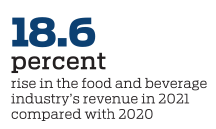Dining out with style enjoying a renaissance across nation's cities

Fine dining has gained greater acceptance among domestic consumers with its market size expanding 40 percent year-on-year in 2021, according to the China Fine Dining Report released by the tech and retail giant Meituan earlier this month.
The domestic food and beverage industry has seen a quality improvement as the country's "dual circulation" strategy was introduced — in which the domestic market is the mainstay and the domestic and foreign markets reinforce each other — and a growing number of urban residents recognize fine dining, the report said.
Chaoyang district in Beijing is a national hub for high-end restaurants. The report showed that a total of 345 fine dining establishments were operating there in June, up from 303 in 2020.
The capital is now home to 36 restaurants named in the 2022 Black Pearl Restaurant Guide, only behind Shanghai with 61. The rankings were created by Meituan in 2018 with the aim of establishing China's own 'Michelin Guide'.
This year's guide published in March listed 283 restaurants from 22 Chinese cities and districts as well as four foreign cities including Paris and Bangkok.
Of them, 16 restaurants were rated three-diamond, the highest ranking, and 63 restaurants won two-diamond status.
Analysts from Meituan said fine dining today is no longer limited to first and second-tier cities where delicacies from around the world are gathered; it also thrives in smaller cities with authentic local food.
For example, Laobian Restaurant in Taizhou, Zhejiang province, has been rated one-diamond in the guide for three consecutive years. It is known for affordable prices and delectable Zhejiang cuisine.
The third-tier city of Shantou in Guangdong province has four Black Pearl-listed restaurants. In addition, Shunde district in the city of Foshan is home to three one-diamond restaurants.
One of the major reasons behind the phenomenon is that the general F&B market is flourishing, according to China Food Newspaper.
In 2021, the F&B sector recorded an annual revenue of 4.69 trillion yuan ($668 billion). This marked a surge of 18.6 percent year-on-year and a rebound to pre-pandemic levels.
Consumers in lower-tier cities want to improve the quality of their lives and their pockets are bulging with disposable income. Therefore they have an increased demand for fine dining, industry insiders said.
Fancy restaurants also achieved a digital transformation driven by information technologies and enhanced brand awareness, partly due to the popularity of social media platforms.
Young people including the post-2000 generation will be the main consumers of the dining market in the next decade, said Dong Zhenxiang, a chef and the founder of Da Dong, a high-end roast duck restaurant chain.
Restaurants must stay motivated and embrace innovation to cater to the latest trends in catering consumption, Dong said.
zhanglinwan@chinadaily.com.cn


















